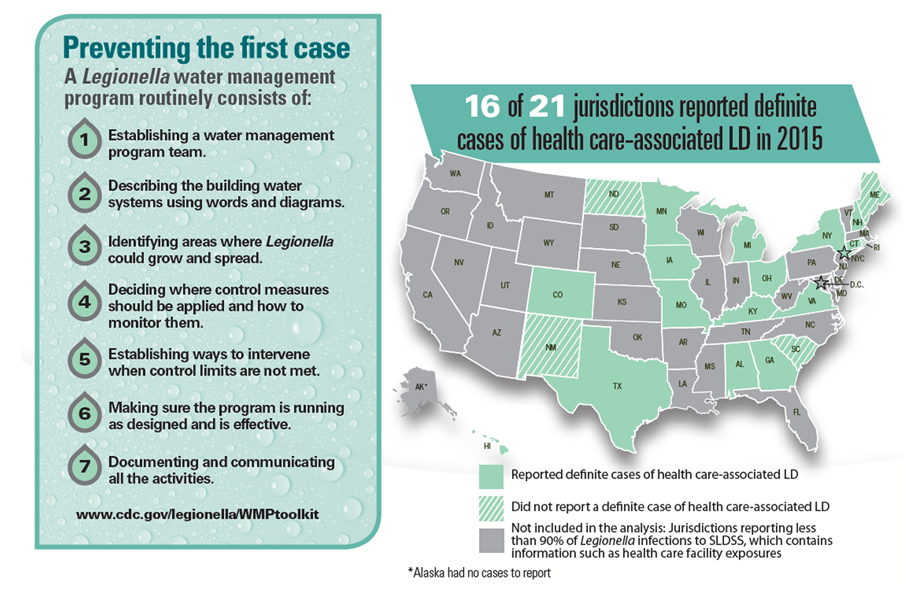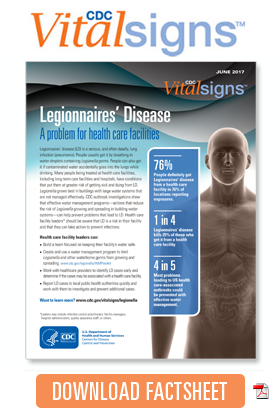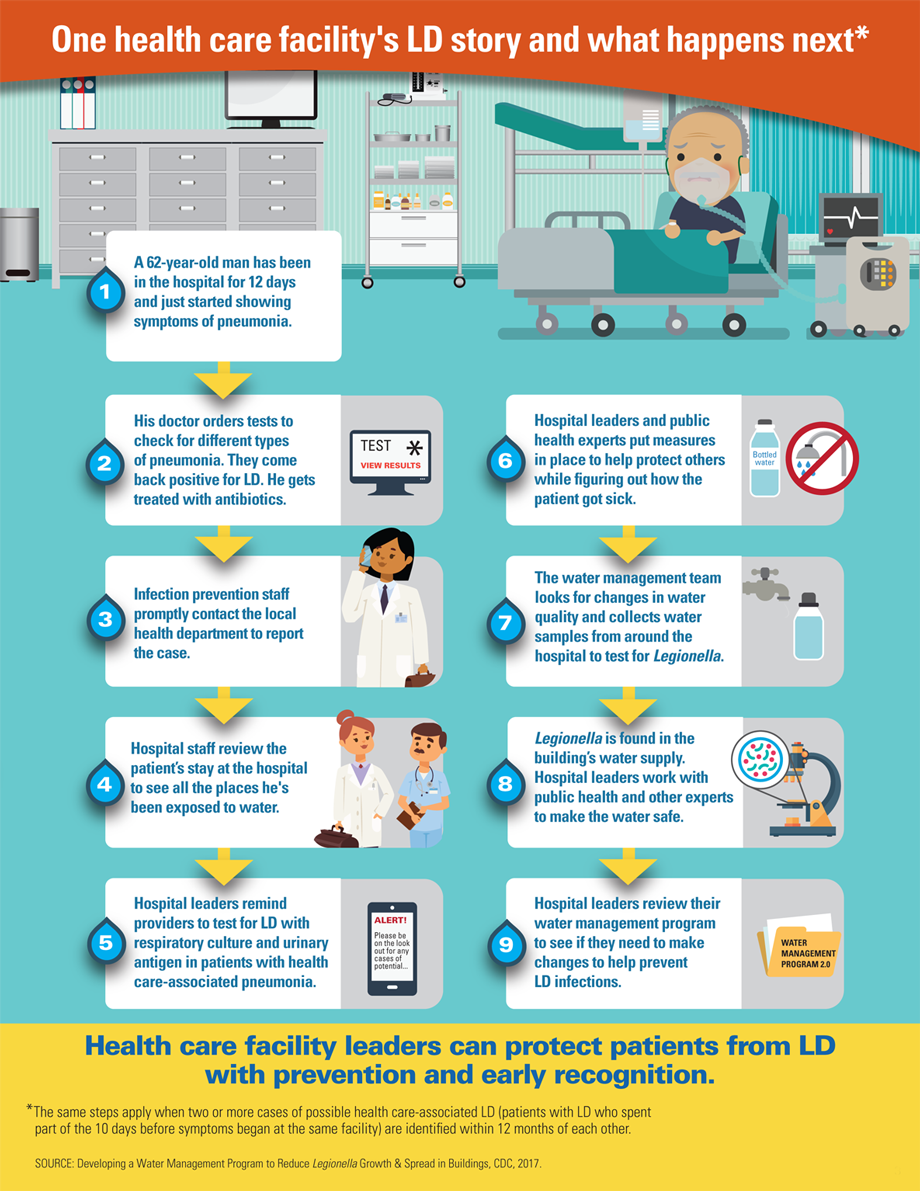Legionnaires’ Disease
A problem for health care facilities
Overview
Legionnaires’ disease (LD) is a serious, and often deadly, lung infection (pneumonia). People usually get it by breathing in water droplets containing Legionella germs. People can also get it if contaminated water accidentally goes into the lungs while drinking. Many people being treated at health care facilities, including long-term care facilities and hospitals, have conditions that put them at greater risk of getting sick and dying from LD. Legionella grows best in buildings with large water systems that are not managed effectively. CDC outbreak investigations show that effective water management programs—actions that reduce the risk of Legionella growing and spreading in building water systems—can help prevent problems that lead to LD. Health care facility leaders* should be aware that LD is a risk in their facility and that they can take action to prevent infections.
Health care facility leaders can
- Build a team focused on keeping their facility’s water safe.
- Create and use a water management program to limit Legionella and other waterborne germs from growing and spreading. cdc.gov/legionella/WMPtoolkit
- Work with healthcare providers to identify LD cases early and determine if the cases may be associated with a health care facility.
- Report LD cases to local public health authorities quickly and work with them to investigate and prevent additional cases.
*Leaders may include infection control practitioners, facility managers, hospital administrators, quality assurance staff, or others.

People definitely got Legionnaires’ disease from a health care facility in 76% of locations reporting exposures.
Legionnaires’ disease kills 25% of those who get it from a health care facility.
Most problems leading to US health care-associated outbreaks could be prevented with effective water management.
Problem
Legionnaires’ disease can occur in your health care facility
Health care facilities may put people at risk for LD when they do not have an effective water management program. These limit germ growth by:
- Keeping hot water temperatures high enough.
- Making sure disinfectant amounts are right.
- Keeping water flowing (preventing stagnation).
- Operating and maintaining equipment to prevent slime (biofilm), organic debris, and corrosion.
- Monitoring factors external to buildings, such as construction, water main breaks, and changes in municipal water quality.
Contaminated water droplets can be spread by:
- Showerheads and sink faucets.
- Hydrotherapy equipment, such as jetted therapy baths.
- Medical equipment, such as respiratory machines, bronchoscopes, and heater-cooler units.
- Ice machines.
- Cooling towers (parts of large air-conditioning systems).
- Decorative fountains and water features.
Health care facility leaders and providers should be aware that some people are at increased risk for LD:
- Adults 50 years or older.
- Current or former smokers.
- People with a weakened immune system or chronic disease.

What Can Be Done
The Federal government is
- Promoting LD prevention practices and providing tools on how to develop water management programs for health care facilities and other at-risk buildings.
- Requiring LD prevention programs at Veterans Health Administration health care facilities. http://bit.ly/2pIRrhL
- Providing information on technologies for Legionella control in building plumbing systems. http://bit.ly/2cA7w3L
- Tracking LD and providing guidance in responding to outbreaks to find the source and help prevent more infections.
Health care facility leaders can
- Build a team focused on keeping their facility’s water safe.
- Create and use a water management program to limit Legionella and other waterborne germs from growing and spreading. https://www.cdc.gov/legionella/WMPtoolkit
- Work with healthcare providers to identify LD cases early and determine if the cases may be associated with a health care facility.
- Report LD cases to local public health authorities quickly and work with them to investigate and prevent additional infections.
Health care providers can
- Test for LD in people with health care-associated pneumonia, especially those with severe pneumonia or in facilities where other LD cases have been identified or Legionella has been found in the water.
- Test for LD in people with pneumonia who have a weakened immune system or chronic disease, fail outpatient treatment, require intensive care, or report recent travel.
- Order a culture specific for Legionella from a lower respiratory specimen (e.g., sputum), preferably before giving antibiotics. Also order a urinary antigen test.
- Talk to their laboratories to make sure they do Legionella tests on site or have another way to quickly get results.
State and local officials can
- Improve monitoring for LD in health care facilities (including reviewing previous cases to look for patterns), and respond promptly to reports of cases.
- Understand capacity of laboratories to process Legionella specimens, and encourage laboratories to save patient isolates for public health investigations.
- Report details, including visits to health care facilities, for all LD cases to CDC. http://bit.ly/2pyjn7j
- Report details for all LD outbreaks to CDC’s National Outbreak Reporting System. www.cdc.gov/nors
- Provide tools and information to help health care facility leaders create and use Legionella water management programs.
Issue Details
- Vital Signs Issue details: Legionnaires’ Disease, Morbidity and Mortality Weekly Report (MMWR)
- Vital Signs – Legionnaires’ Disease [PODCAST – 1:15 minutes]
- Vital Signs – Legionnaires’ Disease [PSA – 0:60 seconds]
- CDC: About Legionnaires’ Disease – English | Spanish
- CDC: Healthcare-associated Infections Website
- CDC: Healthy Water Website
Planning Guides and Toolkits
- CDC: Developing a Water Management Program to Reduce Legionella Growth and Spread in Buildings: A Practical Guide to Implementing Industry Standards
- CDC: Developing a Legionnaires’ Disease Laboratory Response Plan: A Practical Guide for State and Local Public Health Laboratories
- CDC: Drinking Water Advisory Communication Toolbox
- CDC: Emergency Water Supply Planning Guide for Hospitals and Healthcare Facilities
- CDC: Investigation Tools for Clusters and Outbreaks of Legionnaires’ Disease
- Medline Plus – Legionnaires’ Disease
- ASHRAE Standard 188: Legionellosis: Risk Management for Building Water Systems (ANSI Approved)
- ASHRAE Guideline 12-2000: Minimizing the Risk of Legionellosis Associated with Building Water Systems
- Cooling Technology Institute: Legionellosis Guideline: Best Practices for Control of Legionella
- Centers for Medicare and Medicaid Services: Memo on Requirement to Reduce Legionella Risk in Healthcare Facility Water Systems to Prevent Cases and Outbreaks of Legionnaires’ Disease
- Veterans Health Administration: Prevention of Healthcare-Associated Legionella Disease and Scald Injury from Potable Water Distribution Systems [PDF 359KB]
- Environmental Protection Agency: Technologies for Legionella Control in Premise Plumbing Systems: Scientific Literature Review
- Alliance to Prevent Legionnaires’ Disease: Legionnaires’ Disease: Lines of Prevention (Infographic)
- Page last reviewed: June 6, 2017
- Page last updated: June 6, 2017
- Content source:


 ShareCompartir
ShareCompartir

